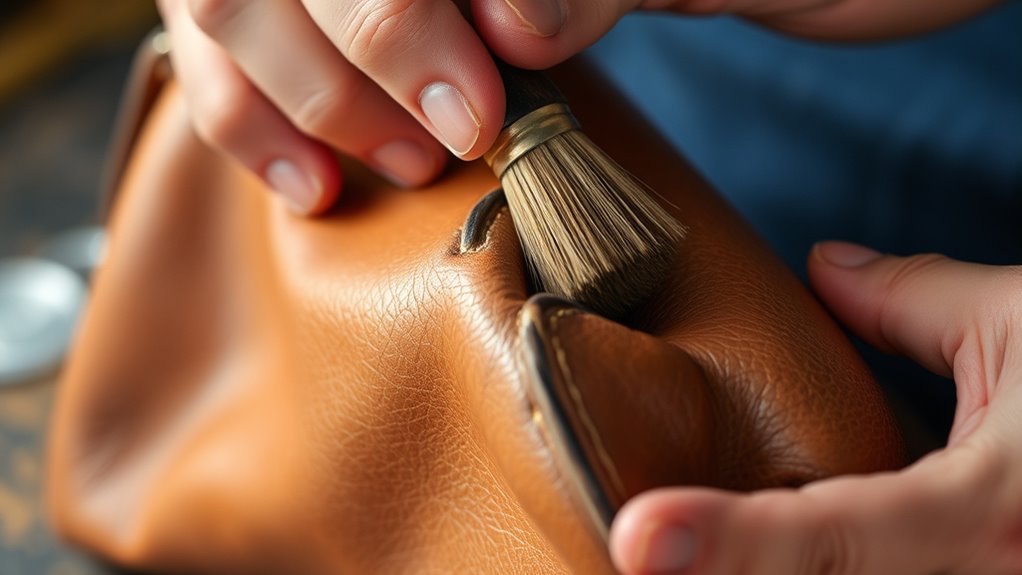When deciding whether to repair or replace your bag, assess its overall condition, material, age, and sentimental value. If damage is minor and repairs are affordable, professional restoration can extend its life and preserve value. For deeply damaged or outdated styles, replacing may be wiser. Consider repair costs versus the bag’s worth and how it fits your style. Want tips on choosing the best option? Keep exploring to find out more.
Key Takeaways
- Assess the extent of damage; minor cosmetic issues often justify repair, while significant structural damage may warrant replacement.
- Consider the bag’s sentimental, vintage, or brand value, which can make restoration more worthwhile.
- Compare repair costs against the price of a new bag to determine economic viability.
- Evaluate the material type; leather and high-quality fabrics typically respond well to repair, unlike low-grade materials.
- Factor in repair time and expertise needed; professional restoration is worth it if it preserves the bag’s appearance and value effectively.
Assessing the Extent of Damage

Before deciding whether to repair or replace, you need to accurately assess the extent of the damage. Start by examining the bag’s overall condition, paying close attention to the bag color—fading, discoloration, or staining can influence your decision. Check the hardware finish for scratches, tarnishing, or corrosion, as these issues could require professional attention or replacement. Look for structural damage like torn seams, broken clasps, or weakened handles. Consider whether the damage affects the bag’s functionality or just its appearance. Small scratches on the hardware or slight discoloration in the bag color might be worth repairing, while significant structural issues or severe damage could mean replacement is the better option. A thorough assessment helps you make an informed choice. Additionally, evaluating the aesthetic appeal of the bag can help determine if restoration will bring it back to a desirable condition. Conducting a comprehensive damage assessment can also reveal whether the repair costs are justified compared to the value of the bag. Understanding the extent of damage is crucial for making a cost-effective and practical decision, especially considering how market value impacts the overall worth of the bag.
Evaluating the Age and Style of the Bag
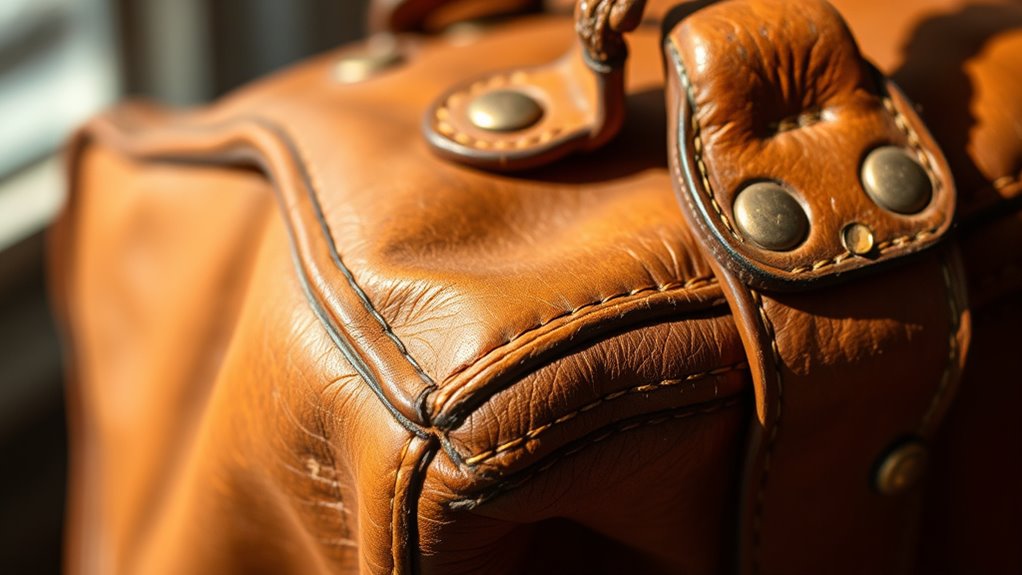
When deciding whether to repair or replace your bag, consider its age and style to determine its value. Vintage pieces often have unique charm but may need more care, while modern designs might align better with current trends and durability. Understanding these factors helps you choose the best option for preserving or upgrading your bag. Additionally, assessing the emotional attachment you have to the item can influence your decision, especially if the bag holds sentimental significance. Recognizing the keto-friendly ingredients in your bag’s material or care products can also be beneficial to maintain its condition and health. Moreover, evaluating the wear and tear can help identify whether professional restoration can effectively extend the bag’s lifespan. Exploring curiosity-driven approaches may inspire you to discover innovative ways to restore or repurpose your bag, adding a layer of personal satisfaction. Consulting entertainment and parks resources may offer helpful tips on caring for collectible or themed bags.
Vintage vs. Modern Appeal
Deciding between vintage and modern appeal hinges on your personal style and the bag’s overall look. Vintage bags often carry a timeless charm, showcasing craftsmanship from luxury brands with unique details and character. They appeal to those who value history and individuality in their accessories. Modern bags, on the other hand, tend to feature sleek designs, innovative shapes, and eco friendly materials, aligning with current trends and sustainability efforts. If you prefer a classic aesthetic with a story, vintage is the way to go. But if you seek contemporary style and eco-conscious choices, a modern bag might suit you better. Consider how each style complements your wardrobe and personal values before making a decision. Both options can be stylish, but your choice reflects your unique identity. Additionally, understanding the design elements of each style can help you make a more informed choice that aligns with your preferences. Moreover, recognizing how the market trends influence the popularity of vintage versus modern bags can assist you in selecting a piece that remains relevant and valuable over time. Staying aware of brand heritage can also enhance your appreciation of vintage pieces and their enduring appeal.
Material Durability Concerns
Evaluating the material durability of your bag depends on its age and style, as these factors influence how well it holds up over time. Older bags may show signs like leather cracking or fabric fraying, indicating the need for professional care. You might notice:
- Cracks forming along the leather’s surface, weakening its structure
- Frayed edges on fabric panels, risking further unraveling
- Faded or discolored leather from sun exposure
- Worn stitching that threatens the bag’s integrity
- Understanding the type of material used can help determine its resistance to wear and tear over the years. Additionally, knowing about brand reputation can assist in assessing whether the bag is worth restoring or should be replaced. These signs highlight the importance of appraising whether repairs can restore durability or if replacement is necessary. Recognizing the material’s resilience can provide insight into the long-term durability of your bag, especially when considering restoration options. Analyzing the age and style can also reveal if the materials are salvageable with restoration or if they’ve reached the end of their lifespan. Furthermore, inspecting for signs of moisture damage can help evaluate whether the material has suffered from water exposure, which can compromise its integrity over time.
Design and Style Trends
The design and style of your bag reveal much about its age and whether it still aligns with current trends. Examine its overall shape, hardware, and embellishments to assess style consistency. If the bag’s design feels outdated or mismatched with modern aesthetics, it may be worth considering a replacement. When evaluating repair options, consider whether color matching can restore a cohesive appearance, especially if parts have faded or stained. An old bag with a dated style might not benefit from repairs that attempt to preserve its original look. Instead, focus on whether restoring it maintains its vintage charm or if it’s better to embrace a more current design. Additionally, considering grooming and skincare trends can help determine whether a vintage look still complements your overall style. Recognizing shifts in fashion and style trends can guide whether to preserve or update your bag’s appearance for a more contemporary look.
Determining the Material and Its Repairability

Understanding the material of your item is key to deciding whether it can be repaired or should be replaced. You need to contemplate its durability, repair options, and overall costs to make an informed choice. You should also consider the dog’s name to see if it influences your decision, especially if the item is related to your pet’s accessories or belongings. By evaluating these factors, you’ll determine the most practical and cost-effective solution. For example, certain materials like modern toilets are designed with durability and ease of repair in mind, which can influence your decision on whether to restore or replace. Additionally, considering the repairability of the material can help you avoid unnecessary expenses if the item can be effectively restored.
Material Types and Durability
When choosing between repair and replacement, identifying the material type is essential because it directly influences how easily the item can be fixed. Leather offers excellent durability, often lasting decades with proper care, but repairs can be complex and costly. Synthetic materials, on the other hand, tend to have high resilience, resisting water and scratches better, and often are easier to repair or restore. Knowing whether your bag is genuine leather or synthetic influences your decision.
- Imagine smooth leather aging gracefully, developing a rich patina over time
- Visualize synthetic fibers bouncing back after a quick clean
- Feel the toughness of genuine leather, resisting tears and scuffs
- Picture synthetic materials resisting water damage and staining
Repair Methods Compatibility
Determining whether a material is repairable requires identifying its composition and how compatible various repair methods are. Some materials, like leather or canvas, respond well to color matching and patching, while others, such as plastics, may need specialized techniques. Hardware restoration is also essential; metal parts can often be cleaned, polished, or re-chromed, but delicate components might require replacement. Use this table to gauge repair compatibility:
| Material Type | Repairability & Methods |
|---|---|
| Leather | Color matching, patching, hardware restoration |
| Canvas | Patching, reinforcement, color touch-up |
| Plastic | Welding, adhesive repair, color matching |
| Metal | Polishing, re-chroming, hardware repair |
| Synthetic | Adhesive repair, color matching |
Matching color and restoring hardware are vital to seamless repairs, ensuring your bag maintains its value.
Cost-Effectiveness Analysis
Evaluating the cost-effectiveness of repairing versus replacing a material hinges on identifying its repairability and the associated costs. You need to contemplate if the material’s aesthetics can be restored without sacrificing style or quality. The decision also involves appraising whether the repair preserves the bag’s brand reputation, which influences its value.
Picture this:
- Restoring intricate stitching that maintains the original material aesthetics
- Matching the original color and texture seamlessly
- Weighing the expense of high-quality repairs against buying new
- Ensuring repairs won’t diminish the bag’s prestige or resale value
Considering the Sentimental Value
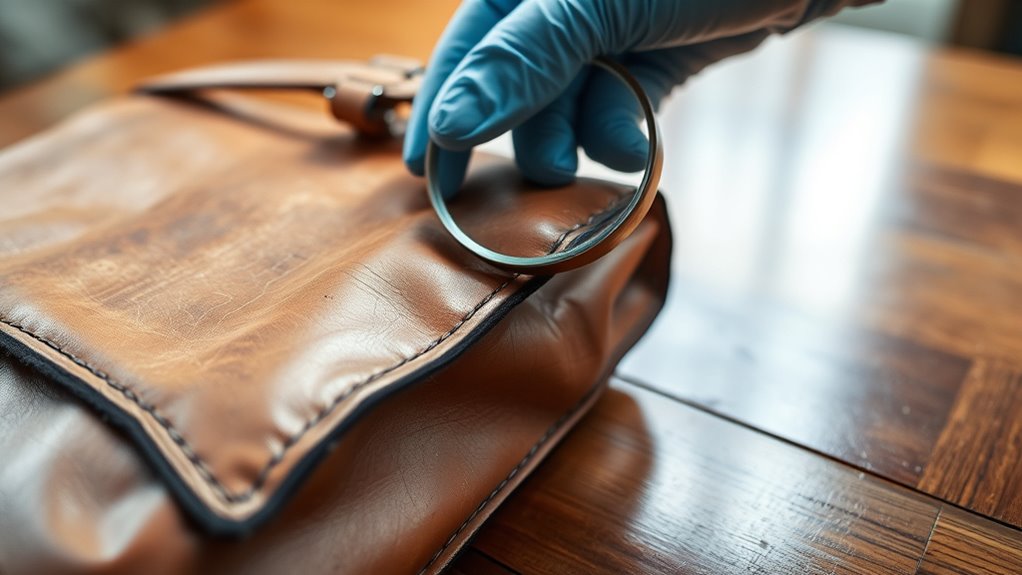
Considering the sentimental value of an item often makes the decision to repair or replace more personal and emotional. If your bag holds memories or represents a special moment, you might prioritize restoring it, regardless of current fashion trends. Its timeless design or the brand reputation could make it more meaningful than a new purchase. Sometimes, the emotional connection outweighs the cost or practicality of replacement. You may find comfort in preserving a piece that reflects your history or personal style, especially if it’s a vintage or heirloom item. Ultimately, weighing sentimental value helps you decide whether repairing the bag keeps its emotional significance intact or if replacing it aligns better with your current lifestyle.
Analyzing Cost-Effectiveness of Restoration
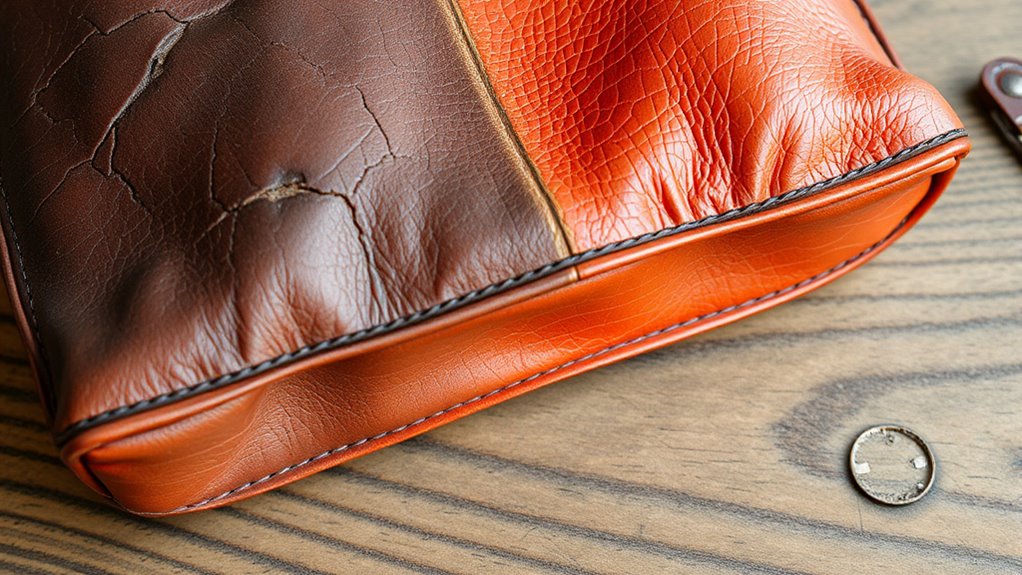
When weighing the cost-effectiveness of restoring an item, it’s important to compare the expenses involved with the potential benefits. Restoration can preserve rare craftsmanship and maintain the bag’s brand value, making it a worthwhile investment. Consider the following:
- The delicate process of repairing intricate stitches and unique materials
- The preservation of original hardware and craftsmanship details
- The potential to retain the bag’s resale value
- The emotional attachment tied to owning a piece of history
Restoration might be more cost-effective if the bag holds significant sentimental or monetary value. It’s essential to evaluate whether the expense aligns with the bag’s worth, especially when its brand reputation and rarity enhance its overall value. Proper analysis helps you make an informed decision about repair versus replacement.
Recognizing Signs of Structural Damage
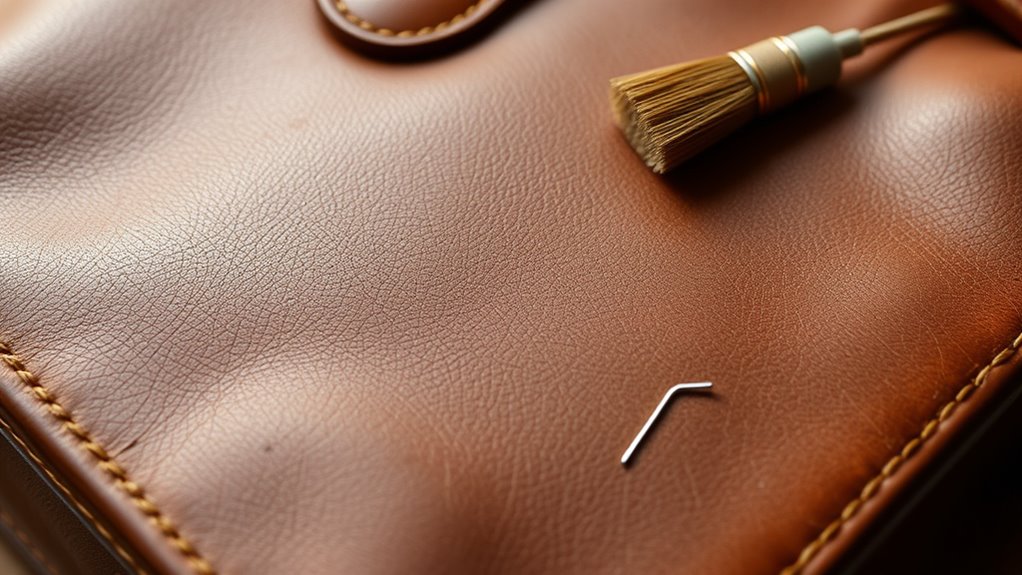
Structural damage in a bag can often be subtle at first, but recognizing the early warning signs is key to preventing further deterioration. Look for uneven seams, loose threads, or cracks in the material, which indicate underlying issues. Pay attention to areas where the material has become weak or shows signs of stress, such as warping or splitting. Ensuring material compatibility is essential—using incompatible repair materials can worsen damage or compromise the bag’s integrity. Additionally, check for inconsistencies in brand branding, like fading logos or mismatched stitching, which might signal previous repairs or damage. Spotting these signs early helps determine whether professional restoration is worth it or if replacement might be the better choice. Proper identification preserves both the value and longevity of your bag.
Weighing the Impact on Aesthetic Appeal

Deciding whether to repair or replace a damaged bag often hinges on how each option affects its visual appeal. You want it to look as close to new as possible, which means considering color matching and hardware replacement. A professional restoration can seamlessly blend repairs with the original material, preserving the bag’s integrity. Think about:
- Matching the exact shade of leather or fabric to prevent noticeable differences
- Ensuring hardware replacement looks consistent with the original metal finish
- Restoring the bag’s sheen and texture for a fresh, polished appearance
- Maintaining the original design details without distortions
These factors determine whether a repair enhances or diminishes your bag’s aesthetic. Proper attention to color matching and hardware replacement guarantees your bag remains stylish and valuable.
Understanding the Repair Process and Timeframe
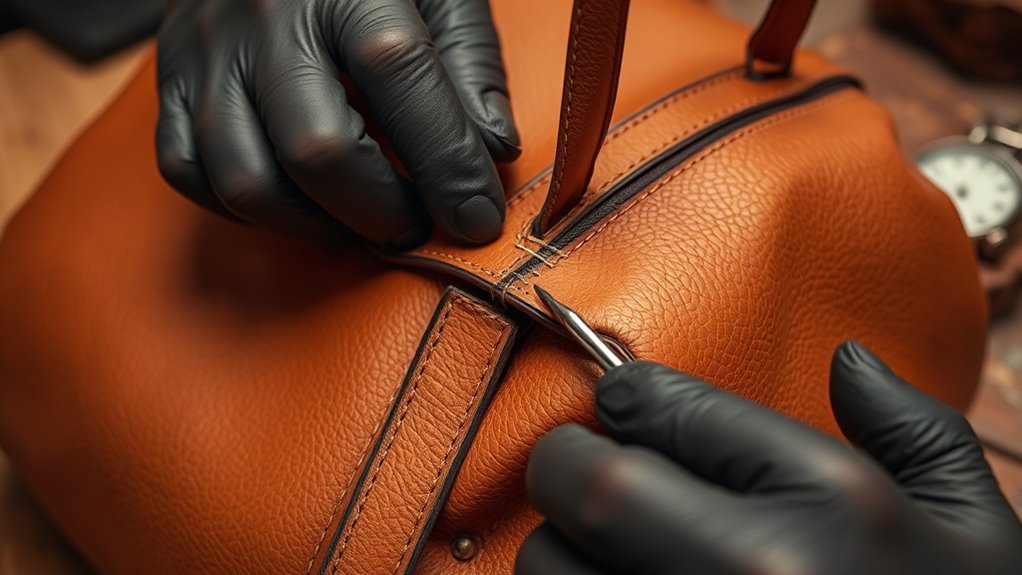
When you start a repair, you’ll go through several key steps, from assessment to the actual fixing process. The typical timeline can vary depending on what’s involved, but understanding the general timeframe helps you plan ahead. Factors like the repair’s complexity and available parts can influence how long it takes, so being aware of these can set realistic expectations.
Repair Steps Overview
Understanding the repair process and its timeframe is essential before deciding whether to repair or replace. When you choose professional restoration, the steps typically include evaluating the damage, sourcing quality materials that match current fashion trends, carefully cleaning and repairing the bag, and finally, finishing touches to restore its original look. Each step considers preserving the brand reputation and style integrity, ensuring your bag remains fashionable. Visualize technicians examining stitches, sourcing authentic hardware, meticulous handwork, and a final quality check. The entire process can vary depending on the extent of damage but generally aims to minimize downtime while maintaining high standards. Knowing these steps helps you gauge if a repair aligns with your timeline and value for your cherished bag.
Typical Restoration Timeline
A clear grasp of the typical restoration timeline helps you set realistic expectations for the repair process. Usually, the process begins with an assessment, followed by color matching to ensure repairs blend seamlessly. This step can take a few days, especially if custom dyeing is needed. Next, hardware replacement may be required if original pieces are damaged or missing; sourcing or fabricating these parts can add additional time. Once repairs are underway, expect several days for restoration work, including cleaning, stitching, and finishing touches. Overall, the entire process can range from one to three weeks, depending on the bag’s condition and the complexity of repairs. Knowing this timeline helps you plan accordingly and decide if restoration is worth the wait.
Factors Influencing Duration
Several key factors can considerably influence how long the repair process takes for your bag. The extent of damage, such as severe color fading or hardware tarnishing, plays a big role. If the bag has significant discoloration, restoration might require delicate color matching and multiple layers, extending the timeline. Hardware tarnishing may need careful cleaning or replacement, adding to the process. Additionally, material type impacts duration; delicate leathers demand more attention. The complexity of repairs, like restoring intricate stitching or hardware, also affects timing.
- Degree of color fading, requiring precise color matching
- Severity of hardware tarnishing and cleaning needs
- Material delicacy and repair complexity
- The overall extent of damage affecting repair steps
Identifying Professional Restoration Experts

When choosing a professional restoration expert, it’s vital to verify their credentials and experience. Look for specialists skilled in leather preservation, as this guarantees they understand proper cleaning, conditioning, and repair techniques. A reputable expert will have a portfolio demonstrating successful restorations and references from satisfied clients. Pay attention to their ability to perform precise color matching, which is essential for seamless repairs and maintaining your bag’s original look. Ask about their training and certifications, especially in leather restoration and color matching. Avoid amateurs or those without specialized experience, as improper restoration can cause further damage. The right expert will combine technical expertise with an eye for detail, ensuring your bag’s longevity and preserving its value.
Making the Decision: Repair or Replace
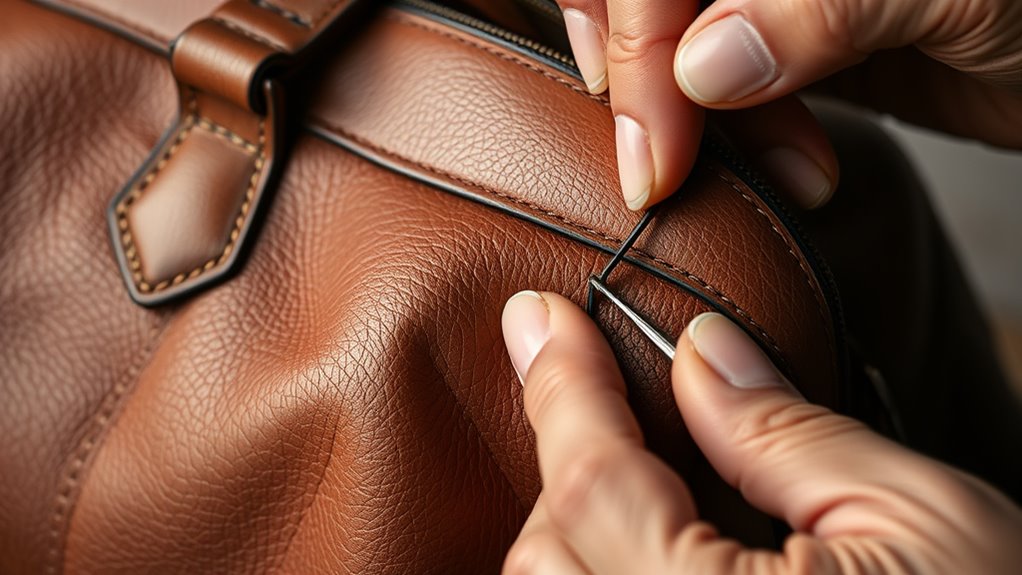
After consulting with a professional restoration expert, you’ll need to weigh whether repairing your leather bag makes sense or if replacing it is the better choice. Consider the bag’s sentimental value, cost-effectiveness, and environmental impact. Repairing can preserve your bag’s history and reduce waste, supporting sustainability. On the other hand, if the damage is extensive or the bag’s brand reputation is compromised, replacement might be smarter. Visualize a worn leather surface, frayed edges, or broken hardware—signs that repair may be limited. Think about these factors:
- The extent of damage and repair feasibility
- Long-term durability after restoration
- The environmental footprint of disposal versus repair
- How the brand’s reputation influences value and trust
Ultimately, balance your emotional attachment with practical and environmental considerations.
Frequently Asked Questions
How Do I Find a Reputable Bag Restoration Professional?
To find a reputable bag restoration professional, start by researching specialists with positive reviews and testimonials. Confirm they have expertise in authenticity verification and use advanced restoration techniques. Ask for before-and-after photos of their work, and inquire about their experience with your specific bag brand. Trust your instincts, and choose someone who communicates clearly and confidently. A skilled professional will restore your bag’s beauty while maintaining its value.
What Are Common Costs Associated With Bag Restoration?
You’re curious about the costs involved in bag restoration, and it’s more than just a price tag. Expect to pay for leather treatment that restores texture and color matching that seamlessly blends repairs. These processes can vary widely depending on the bag’s condition and value. Skilled professionals may charge hourly or flat rates, but investing in quality guarantees your bag’s durability and beauty are maintained.
How Long Does Professional Restoration Typically Take?
When you ask about restoration timelines, it varies based on the bag’s condition and the extent of work needed. Typically, you can expect a professional turnaround of one to three weeks. This timeline allows for thorough cleaning, repairs, and finishing touches. Keep in mind, complex restorations may take longer, but a reputable professional will keep you informed about the estimated restoration timeline, ensuring your bag gets the care it deserves.
Can Restoration Improve a Bag’s Resale Value?
Did you know that a professionally restored bag can increase its resale value by up to 50%? Restoration enhances a bag’s vintage appeal and guarantees material compatibility, making it more attractive to buyers. By carefully repairing and preserving its original features, you boost its desirability and market worth. So, investing in professional restoration can definitely pay off, especially if you aim to maximize your bag’s resale potential.
What Are Signs a Bag Cannot Be Effectively Repaired?
You’ll notice a bag can’t be effectively repaired if leather deterioration is extensive, causing brittle or peeling material. Structural damage, like a broken handle or torn seams, also indicates limited restoration options. If these issues compromise the bag’s integrity or aesthetic, professional repairs may not restore its original quality or value. In such cases, replacing the bag might be more practical than attempting costly, ineffective restoration.
Conclusion
Deciding whether to repair or replace your bag depends on factors like damage, age, and sentimental value. Did you know that 65% of handbag owners find professional restoration worthwhile for sentimental or high-value pieces? If your bag holds emotional or monetary significance, investing in restoration can save you money and preserve memories. Weigh the costs, effort, and aesthetic impact carefully—sometimes, a professional repair is more worthwhile than a brand-new purchase.
